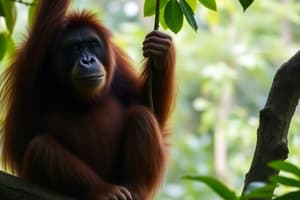Podcast
Questions and Answers
What is the most likely reason Rakus sustained the cheek wound?
What is the most likely reason Rakus sustained the cheek wound?
- A territorial dispute or fight with another orangutan (correct)
- Accidental injury from climbing trees
- Attack from a predator seeking to harm him
- Infection from consuming toxic plants in the rainforest
Why were researchers so intrigued by Rakus's behavior regarding the liana plant?
Why were researchers so intrigued by Rakus's behavior regarding the liana plant?
- The plant has no known properties.
- Sumatran orangutans rarely consume the plant. (correct)
- It is common for Sumatran orangutans to include liana in their daily diet.
- The plant is toxic and not typically consumed by primates.
How did Rakus administer the liana plant to his wound, according to observations?
How did Rakus administer the liana plant to his wound, according to observations?
- He ingested the plant and waited for its compounds to circulate through his bloodstream.
- He chewed the plant and rubbed the juice on the injury, later covering it with the leaves. (correct)
- He created a poultice by crushing the plant with water and applied it as a paste.
- He used a sharp stone to grind the plant into a fine powder before application.
Besides applying the liana plant, what other behavioral changes did Rakus exhibit that suggested he was facilitating his own healing?
Besides applying the liana plant, what other behavioral changes did Rakus exhibit that suggested he was facilitating his own healing?
What does this discovery suggest about the self-awareness and medicinal knowledge of orangutans?
What does this discovery suggest about the self-awareness and medicinal knowledge of orangutans?
Given that Sumatran orangutans are critically endangered, how might observations such as this one impact conservation efforts?
Given that Sumatran orangutans are critically endangered, how might observations such as this one impact conservation efforts?
What are the primary factors contributing to the Sumatran orangutans' critically endangered status?
What are the primary factors contributing to the Sumatran orangutans' critically endangered status?
If the liana plant is proven to have significant medicinal properties, what ethical considerations should be addressed regarding its use?
If the liana plant is proven to have significant medicinal properties, what ethical considerations should be addressed regarding its use?
Flashcards
Rakus
Rakus
A Sumatran orangutan observed treating a cheek wound with a medicinal plant.
Gunung Leuser National Park
Gunung Leuser National Park
A protected rainforest in Sumatra, Indonesia, home to orangutans and other species.
Isabelle Laumer
Isabelle Laumer
Dr. Laumer and her team first noticed Rakus's wound.
Liana
Liana
Signup and view all the flashcards
Wound treatment
Wound treatment
Signup and view all the flashcards
Leaf bandage
Leaf bandage
Signup and view all the flashcards
Healing time
Healing time
Signup and view all the flashcards
Sumatran Orangutans
Sumatran Orangutans
Signup and view all the flashcards
Study Notes
- Rakus, a Sumatran orangutan, healed a cheek wound using a medicinal plant.
- The orangutan lives in Gunung Leuser National Park, a rainforest in Sumatra, Indonesia which houses over 750 animal species, inclusive of 150 orangutans.
- Dr. Isabelle Laumer and her team first noticed Rakus' wound on June 22, 2022, which they believed was due to a fight with another orangutan.
- Three days later, Rakus was observed chewing on the stems and leaves of a tropical vine called liana.
- Locals know the liana plant for its healing properties.
- Sumatran orangutans rarely consume liana.
- Rakus spent 13 minutes eating the liana plant and then seven minutes applying the juice to his injury.
- Rakus covered the wound with liana leaves to keep flies away.
- The wound closed within five days and was completely healed by July 19, 2022, leaving only a scar.
- This is the first known case of active wound treatment in a wild animal using a medicinal plant.
- The findings were published in the journal Scientific Reports on May 2, 2024.
- Rakus returned to the liana plant the day after initial treatment to eat more leaves and rested more than usual.
- Sumatran orangutans are critically endangered, with about 14,600 remaining in the wild.
- These orangutans are exclusively found in the northern tip of Sumatra, Indonesia.
- Their population has decreased because rainforests are converted into oil palm plantations, and agricultural developments.
- The orangutans are often captured for food or kept as status symbols, despite legal protection.
- Orangutan populations are susceptible to decline because females give birth to one infant at a time every eight or nine years.
Studying That Suits You
Use AI to generate personalized quizzes and flashcards to suit your learning preferences.
Description
Rakus, a Sumatran orangutan, was observed treating a cheek wound with a medicinal liana plant. He chewed the leaves and stems of the plant, applying the juice to his injury. This is the first documented case of active wound treatment by a wild animal using a known medicinal plant.





